Analysis of the Influence of Complex Terrain around DC Transmission Grounding Electrodes on Step Voltage
Abstract
1. Introduction
2. Materials and Methods
2.1. Principle
- (1)
- The current diffusion law around the earth electrode is divergent, as shown in Figure 1. Vertical downward current diffusion and horizontal outward current diffusion.
- (2)
- The current diffusion is more inclined towards the low resistance region.
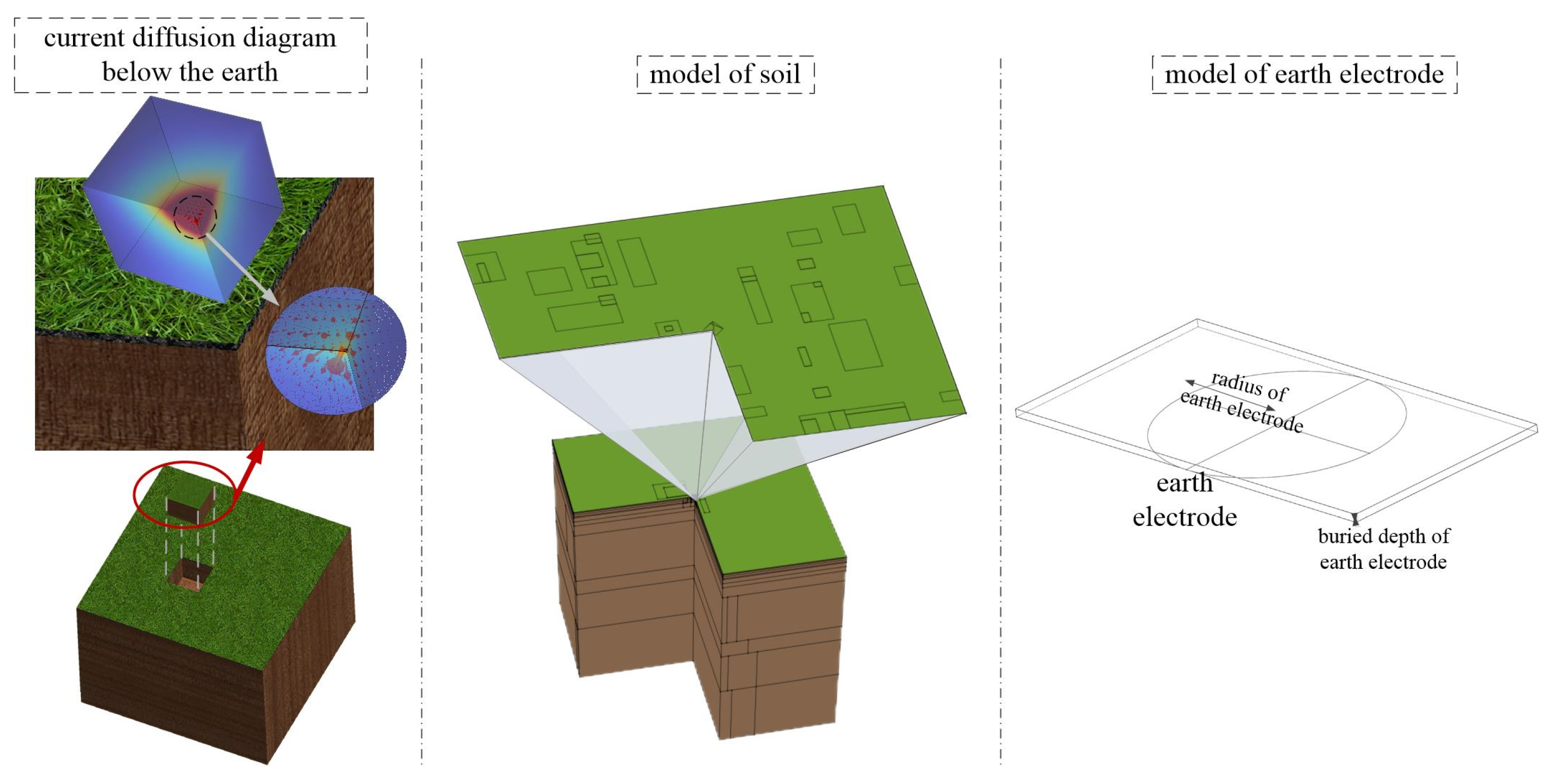
2.2. Rationality Verification
2.3. Cave Model Support
2.4. Underground River Model Support
3. Results and Discussion of Caves
3.1. The Influence of Fillings on Surface Step Voltage
3.2. The Influence of Position on Ground Step Voltage
- The closer the karst cave is to the earth electrode, the higher the maximum step voltage of the surface is. According to the analysis of 3.1, there are underground caverns that distort the surface step voltage, which are also seen in this section. The closer the distance to the earth electrode is, the greater the influence of the resistivity difference on the current dispersion is, and the more concentrated it is in the direction of the cave. According to Formula (3), the more the current accumulates in this direction on the surface, the higher the maximum step voltage.
- The maximum step voltage of a karst cave within the earth electrode is higher than that of a karst cave outside the earth electrode when both are at the same distance from the earth electrode. The karst cave is at the same distance from the polar ring, and the greater the vertical direction is (as shown in Figure 5, the position of a and b; this point accounts for more than b in the vertical direction), the lower the maximum surface step voltage is. The dispersion flow of the polar ring is always vertically downward and horizontally outward. The horizontal projection of a karst cave outside the polar ring has a greater influence on the dispersion flow than that inside the polar ring; at the same distance, the influence of the vertical aspect of the cave is greater than the horizontal aspect.
- The location range of the karst cave satisfying the safety limit (positive east direction) is shown in the opposite direction of the arrow in Figure 5. The red arrow indicates the direction in which the value of the step voltage exceeds the limit.The safe distance between the location of the cave and the polar ring has the following seven sets of data, such as Table 5, where d is the distance between the cave and the polar ring. In Table 4, the maximum value is taken as the safe distance. When d > 350.1 m, the maximum value of the surface step voltage does not exceed the safe range.
3.3. The Influence of Volume on Surface Step Voltage
3.4. The Influence of Shape on Surface Step Voltage
3.4.1. A Regular Sphere and Its Variants
3.4.2. A Regular Cylinder and Its Variants
3.4.3. A Regular Truncated Cone and Its Variants
3.4.4. Extremely Irregular Shapes
3.4.5. Shape Summary
4. Results and Discussion of Underground Rivers
4.1. Rotation Position Analysis
4.2. Analysis of Hydraulic Gradient
4.3. Overall Shape Analysis
- The number of tributaries is the same (single tributary), the mainstream is unchanged, and the maximum surface step voltage is larger on the side of the tributary near the polar ring than on the side away from the polar ring. Similar to the location analysis of cave-type karst caves, the closer to the polar ring, the greater the maximum surface step voltage.
- The maximum surface step voltage increases with the increase of the number of tributaries of the underground river. Therefore, for the overall shape, the more dispersed the shape ( the more tributaries ), the greater the impact on the surface step voltage, the greater the maximum surface step voltage, and the easier it is to exceed the full range.
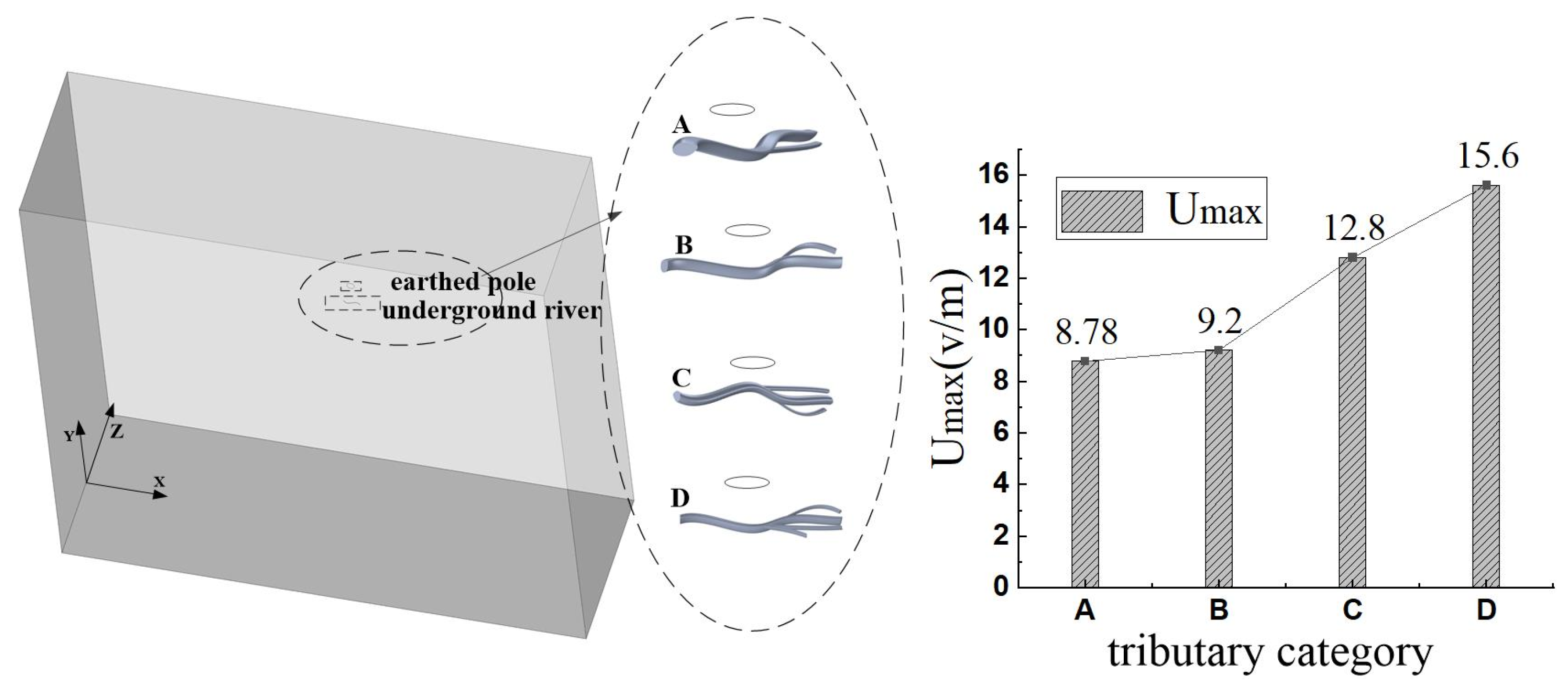
4.4. Cross-Section Shape Analysis
5. Conclusions and Prospects
- In the model analysis of the cave, the influences of different fillings on the maximum step voltage of the surface are within 0.02% of each other; the closer the location of the karst cave to the grounding electrode, the greater the maximum value of the surface step voltage; and there is a position range that meets the safety limit of the step voltage. The surface step voltage of super-large caves is 12% higher than that of small caves, and the volume effect cannot be ignored. The influence of different shapes on the surface step voltage has a corresponding influence on the degree of safety judgment value.
- In the model analysis of the underground river, the influence of the rotation position cannot be ignored. The maximum value of the surface step voltage corresponding to the rotation position of 90 degrees is about 121% higher than that of 0 degrees. The influence of the hydraulic gradient cannot be ignored. A hydraulic gradient of 7% compared to 1% increases the maximum surface step voltage by 116%. The closer the tributary is to the grounding electrode and the larger the number of tributaries is, the easier it is for the surface step voltage to exceed the safety limit. The more regular the cross-section shape is, the more easily the surface step voltage exceeds the safety limit, which proves that the simulation value can provide a reference for practice.
Author Contributions
Funding
Data Availability Statement
Conflicts of Interest
References
- Alassi, A.; Bañales, S.; Ellabban, O.; Adam, G.; MacIver, C. HVDC transmission: Technology review, market trends and future outlook. Renew. Sustain. Energy Rev. 2019, 112, 530–554. [Google Scholar] [CrossRef]
- Acevedo AL, F.; Jahanbani-Ardakani, A.; Nosair, H.; Venkatraman, A.; McCalley, J.D.; Bloom, A.; Osborn, D.; Caspary, J.; Okullo, J.; Bakke, J.; et al. Design and valuation of high-capacity HVDC macrogrid transmission for the continental US. IEEE Trans. Power Syst. 2020, 36, 2750–2760. [Google Scholar] [CrossRef]
- Oliver, D.M.; Zheng, Y.; Naylor, L.A.; Murtagh, M.; Waldron, S.; Peng, T. How does smallholder farming practice and environmental awareness vary across village communities in the karst terrain of southwest China? Agric. Ecosyst. Environ. 2020, 288, 106715. [Google Scholar] [CrossRef]
- Mohapatra, S.K. Design Considerations for HVDC Ground Electrode System. Water Energy Int. 2019, 62, 31–37. [Google Scholar]
- Ai, L. Soil Impulse Current Density Measurement and Influence of Karst Landform on Current Scattering. Master’s Thesis, Chongqing University, Chongqing, China, May 2014. [Google Scholar]
- Auler, A.S. Karst Landforms in the Lagoa Santa Area. In Lagoa Santa Karst: Brazil’s Iconic Karst Region; Springer: Cham, Switzerland, 2020; pp. 109–134. [Google Scholar]
- Auler, A.S. Karst hydrogeology, geomorphology and caves. Int. J. Speleol. 2023, 52, 0_1–0_2. [Google Scholar]
- Jörgens, C.; Clemens, M. Electric field and temperature simulations of high-voltage direct current cables considering the soil environment. Energies 2021, 14, 4910. [Google Scholar] [CrossRef]
- Kaznacheev, P.A.; Popov, I.Y.; Modin, I.N.; Zhostkov, R.A. Application of Independent Finite Element Modeling for Estimating the Effect of Simplest Landforms on Results of Inversion of Electrical Resistivity Tomography Data (Example of a Trench with the Triangular Cross-Section). Seism. Instrum. 2020, 56, 531–539. [Google Scholar] [CrossRef]
- Salarieh, B.; De Silva, J.; Kordi, B. High frequency response of grounding electrodes: Effect of soil dielectric constant. IET Gener. Transm. Distrib. 2020, 14, 2915–2921. [Google Scholar] [CrossRef]
- Xiong, Q.; Wang, M.; Huang, H.; Shi, Y.; Tang, H. Establishment of earth model for HVDC earth electrode in complicated terrain. Proc. CSEE 2020, 40, 2269–2277. (In Chinese) [Google Scholar]
- Sakyi, K.S. 3-D consolidation analysis of layered saturated soil using finite element method. Open Mech. Eng. J. 2019, 13, 45–56. [Google Scholar]
- Younes, A.; Hoteit, H.; Helmig, R.; Fahs, M. A robust fully mixed finite element model for flow and transport in unsaturated fractured porous media. Adv. Water Resour. 2022, 166, 104259. [Google Scholar] [CrossRef]
- Leon Bal, A.R.; Meschke, G. Two-phase model for the excavation analysis in partially saturated soft soils using the particle finite element method. Int. J. Numer. Anal. Methods Geomech. 2023, 47, 145–186. [Google Scholar] [CrossRef]
- De Rezende Costa, I.F.; Barbosa, M.C.; Neto, A.D.O.C. Coupled flow in saturated soil around a vertical grounding rod HVDC considering underground water’s action. Electr. Power Syst. Res. 2022, 213, 108754. [Google Scholar] [CrossRef]
- Kasza, Z.; Kovacs, K. Risk analysis about lightning protection for buildings focusing on risk of loss of human life. Procedia Manuf. 2019, 32, 458–465. [Google Scholar] [CrossRef]
- Dladla, V.M.N.; Nnachi, A.F.; Tshubwana, R.P. Analysis of Design Parameters on Substation Earth Grid Safety Limits. Sci. Publ. Group 2022, 10, 61–72. [Google Scholar]
- Damianaki, K.; Christodoulou, C.A.; Kokalis, C.-C.A.; Kyritsis, A.; Ellinas, E.D.; Vita, V.; Gonos, I.F. Lightning Protection of Photovoltaic Systems: Computation of the Developed Potentials. Appl. Sci. 2020, 11, 337. [Google Scholar] [CrossRef]
- Muzirafuti, A.; Boualoul, M.; Barreca, G.; Allaoui, A.; Bouikbane, H.; Lanza, S.; Crupi, A.; Randazzo, G. Fusion of Remote Sensing and Applied Geophysics for Sinkholes Identification in Tabular Middle Atlas of Morocco (the Causse of El Hajeb): Impact on the Protection of Water Resource. Resources 2020, 9, 51. [Google Scholar] [CrossRef]
- Hunt HG, P.; Blumenthal, R.; Nixon, K.J.; Gomes, C. A multidisciplinary forensic analysis of two lightning deaths observed in South Africa. Int. J. Disaster Risk Reduct. 2020, 51, 101814. [Google Scholar] [CrossRef]
- Heppe, R.J. Step potentials and body currents near grounds in two-layer earth. IEEE Trans. Power Appar. Syst. 1979, PAS-98, 45–59. [Google Scholar] [CrossRef]
- Zhou, H.; Deng, Z.; Xu, X. The application of high density resistivity method in the investigation of bedrock surface and karst cave in karst area of southern Sichuan. Theor. Res. Urban Constr. 2022, 35, 119–121. (In Chinese) [Google Scholar]
- Li, A.; Butler, S. Forward modeling of magnetotellurics using Comsol Multiphysics. Appl. Comput. Geosci. 2021, 12, 100073. [Google Scholar] [CrossRef]
- Clement, R.; Bergeron, M.; Moreau, S. COMSOL Multiphysics modelling for measurement device of electrical resistivity in laboratory test cell. In Proceedings of the 2011 COMSOL Conference, Stuttgart, Germany, 26–28 October 2011; p. 13. [Google Scholar]
- Amewode, E.K. Evaluation of Physical Characteristic of Sandy Soil, the Effects of Amendments Using Comsol Multiphysics and Laboratory Experiments. Ph.D. Thesis, University of Cape Coast, Cape Coast, Ghana, October 2020. [Google Scholar]
- Čar, J. Geostructural mapping of karstified limestones. Geologija 2018, 61, 133–162. [Google Scholar] [CrossRef]
- Muhammad, F.; Samgyu, P.; Young, S.S.; Ho Kim, J.; Mohammad, T.; Adepelumi, A.A. Subsurface cavity detection in a karst environment using electrical resistivity (er): A case study from yongweol-ri, South Korea. Earth Sci. Res. J. 2012, 16, 75–82. [Google Scholar]
- Lønøy, B.; Pennos, C.; Tveranger, J.; Fikos, I.; Vargemezis, G.; Lauritzen, S.-E. Delimiting morphological and volumetric elements of cave surveys as analogues for paleokarst reservoir modelling—A case study from the Maaras cave system, northern Greece. Mar. Pet. Geol. 2021, 129, 105091. [Google Scholar] [CrossRef]
- Franke, K.; Müller, H. Procedural generation of 3D karst caves with speleothems. Comput. Graph. 2021, 102, 533–545. [Google Scholar] [CrossRef]
- Li, Y. Application of Well Logging Constrained Inversion of Cross Borehole ERT in Urban Karst Investigation. Master’s Thesis, Shandong University, Jinan, China, 14 June 2020. [Google Scholar]
- Liu, Y. Research on Reservoir Characterization and Key Controlling Factors of Ordovician Yingshan Formation Carbonate Reservoir in Bachu Region. Master’s Thesis, Chengdu University of Technology, Chengdu, China, June 2013. [Google Scholar]
- Migoń, P.; Duszyński, F.; Jancewicz, K.; Kotowska, M.; Porębna, W. Surface-subsurface connectivity in the morphological evolution of sandstone-capped tabular hills–How much analogy to karst? Geomorphology 2023, 440, 108884. [Google Scholar] [CrossRef]
- Gunn, J. Karst groundwater in UNESCO protected areas: A global overview. Hydrogeol. J. 2021, 29, 297–314. [Google Scholar] [CrossRef]
- Saroli, M.; Albano, M.; Moro, M.; Falcucci, E.; Gori, S.; Galadini, F.; Petitta, M. Looking into the Entanglement Between Karst Landforms and Fault Activity in Carbonate Ridges: The Fibreno Fault System (Central Italy). Front. Earth Sci. 2022, 10, 891319. [Google Scholar] [CrossRef]
- Zhang, C. Migration Characteristics and Controlling Factors of Heavy Metal Elements in Polje Soil. Ph.D. Thesis, China University of Geosciences, Wuhan, China, May 2022. [Google Scholar]
- Zhang, C.; Lv, Y.; Zhang, Z. Features of Middle-Lower Ordovician paleo⁃karst caves in western slope area, Tahe Oil Field, Tarim Basin. Pet. Geol. Exp. 2022, 44, 1008–1017+1047. (In Chinese) [Google Scholar]
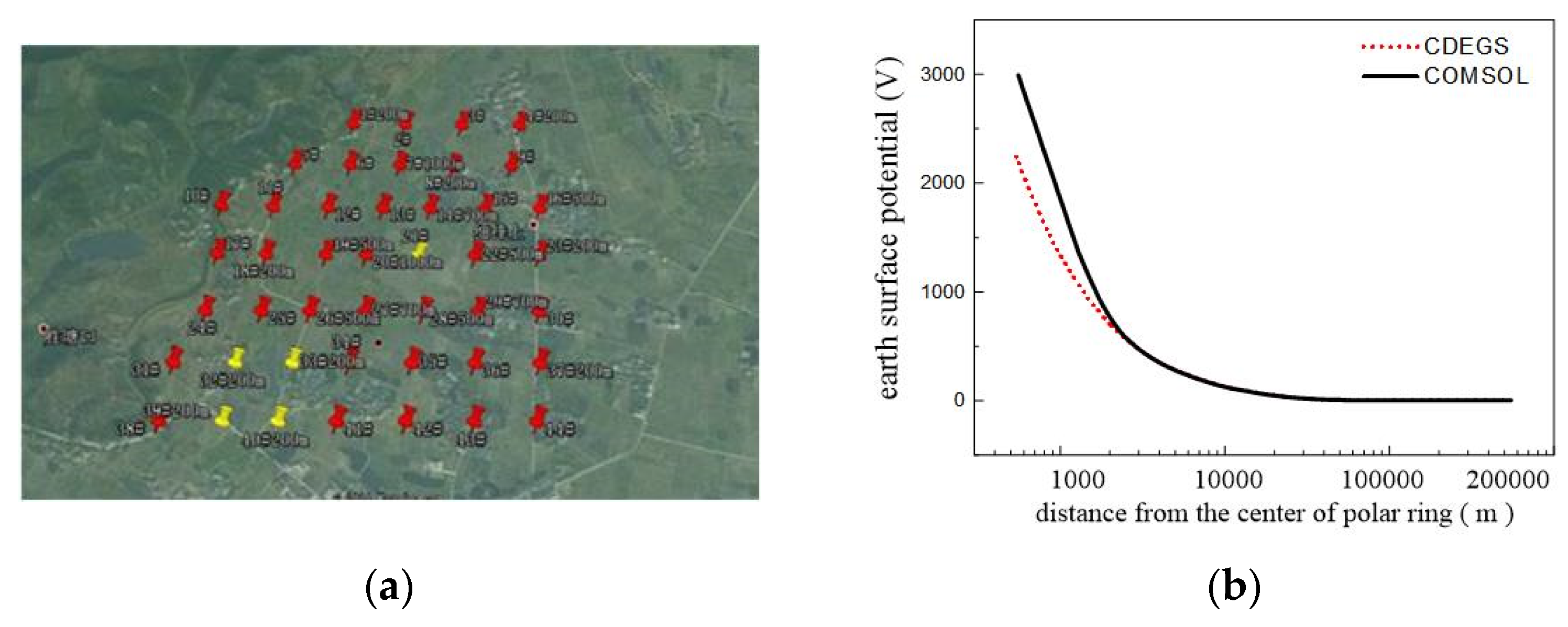
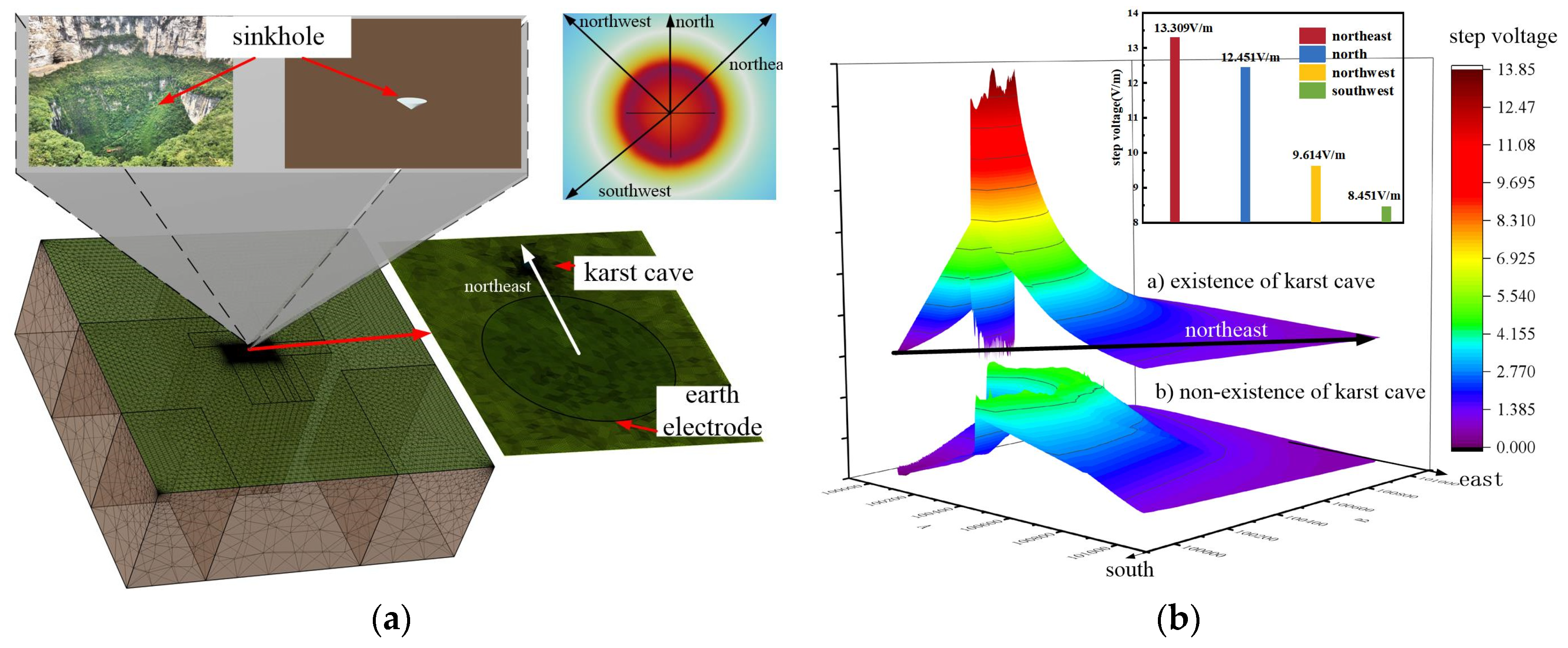
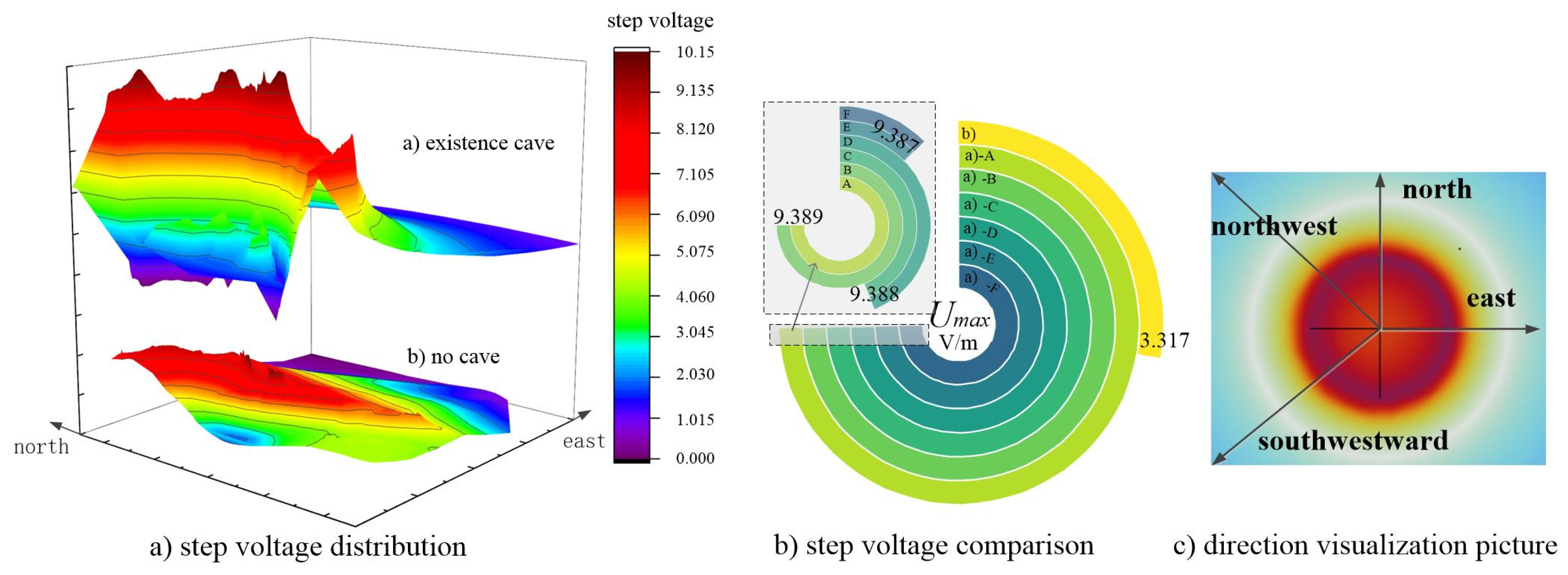
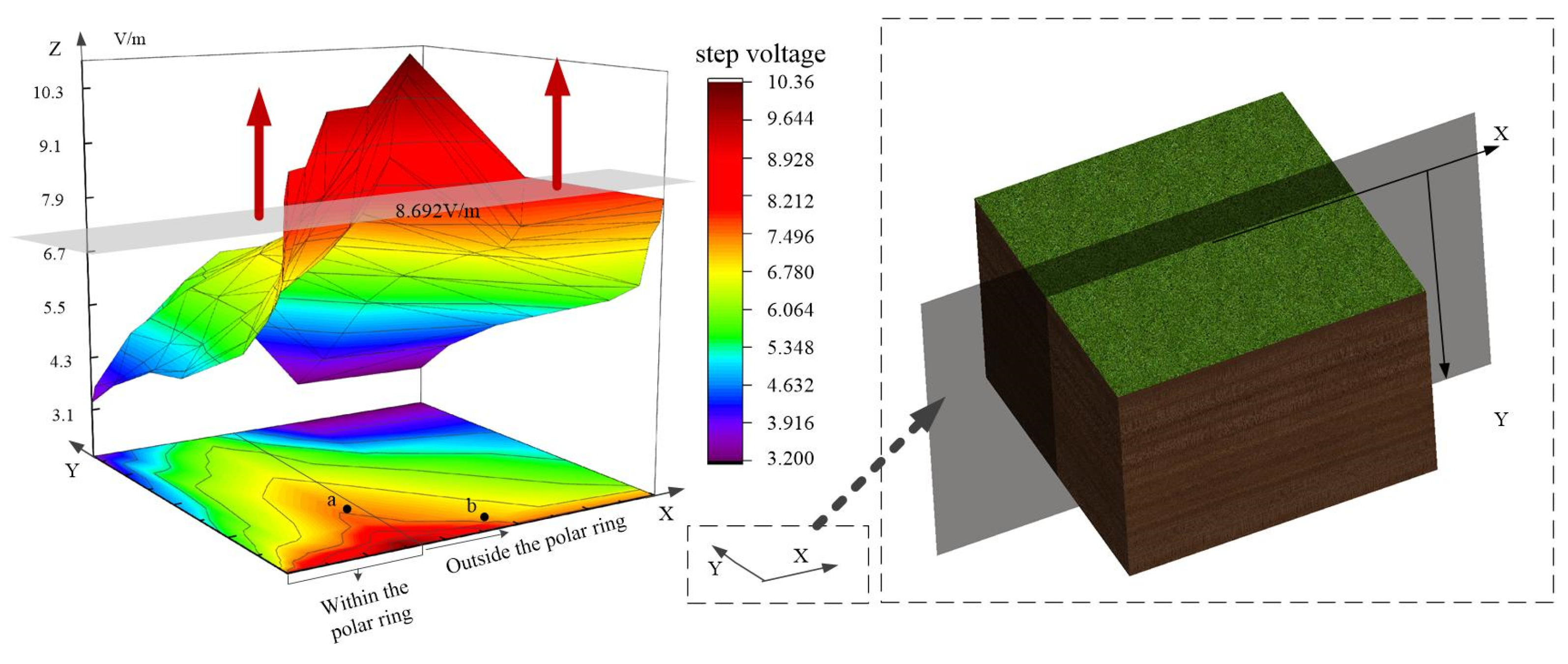
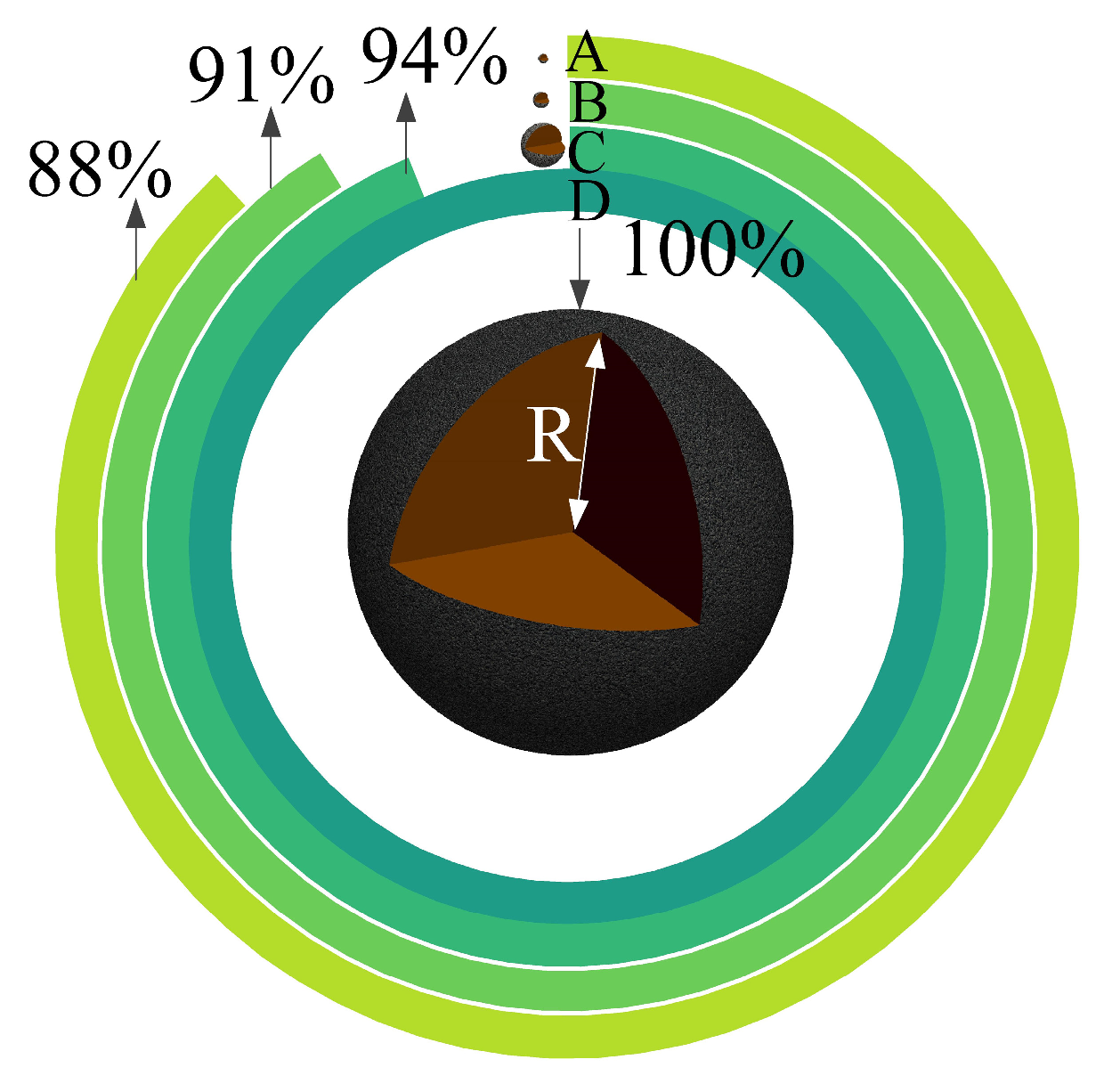
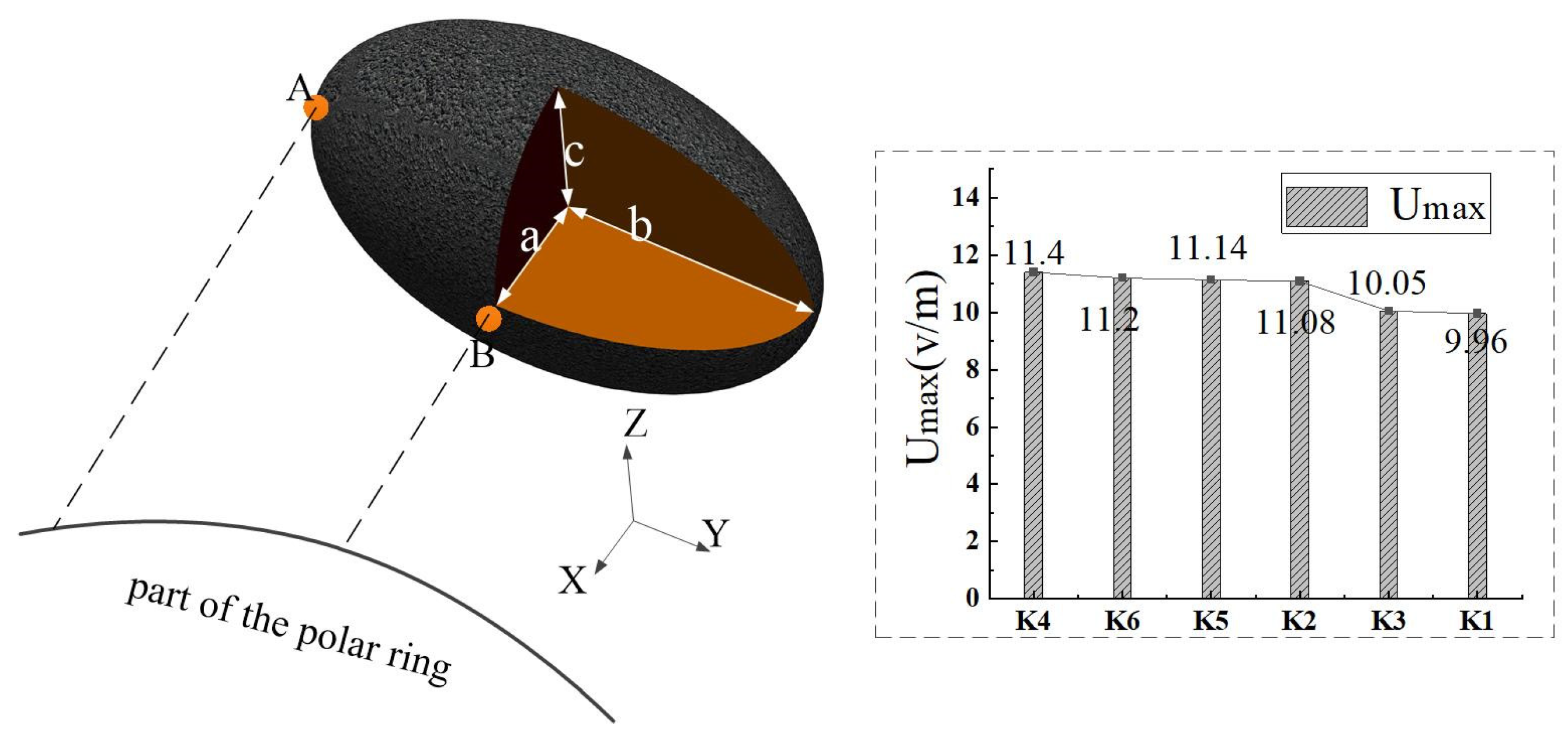
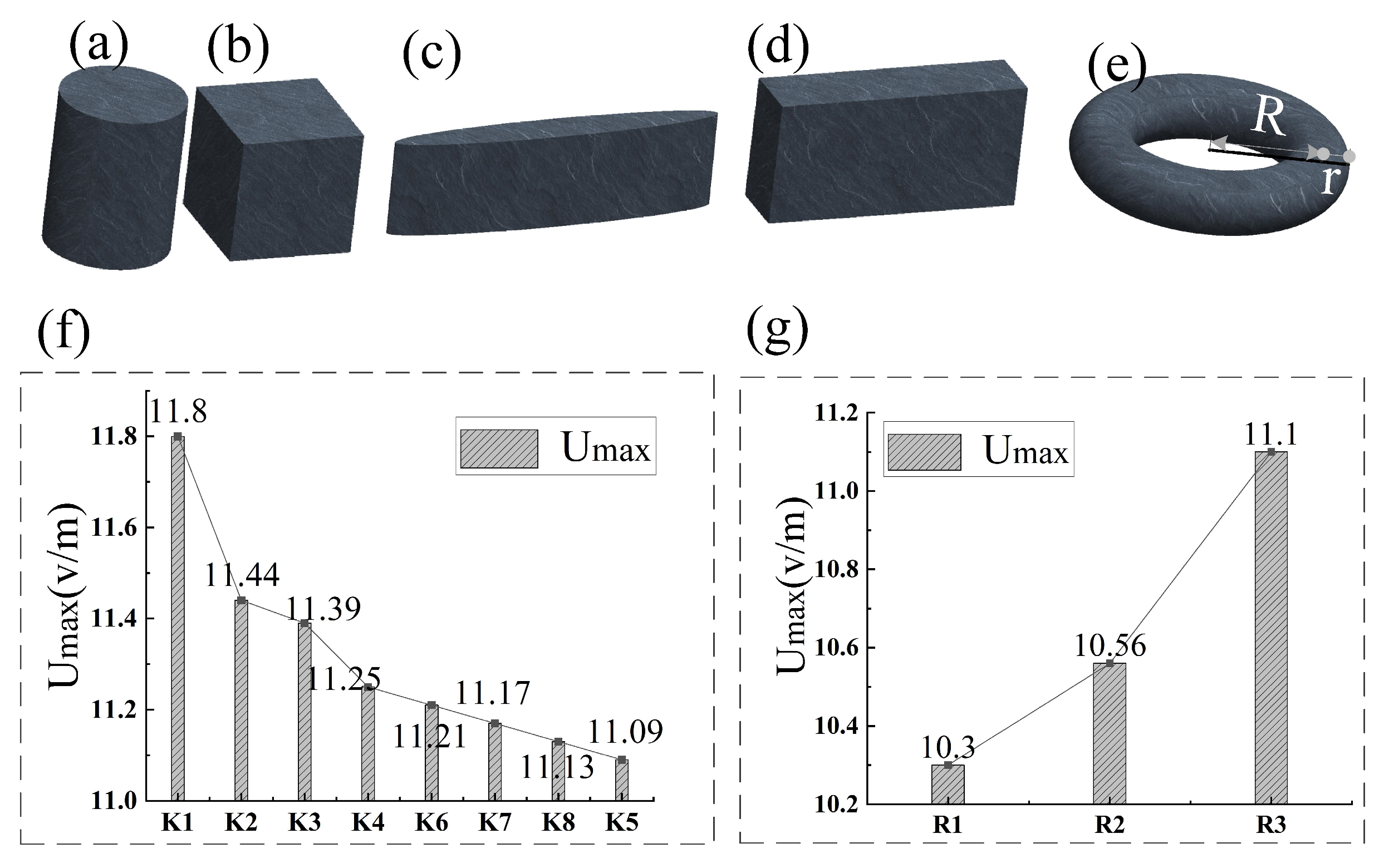


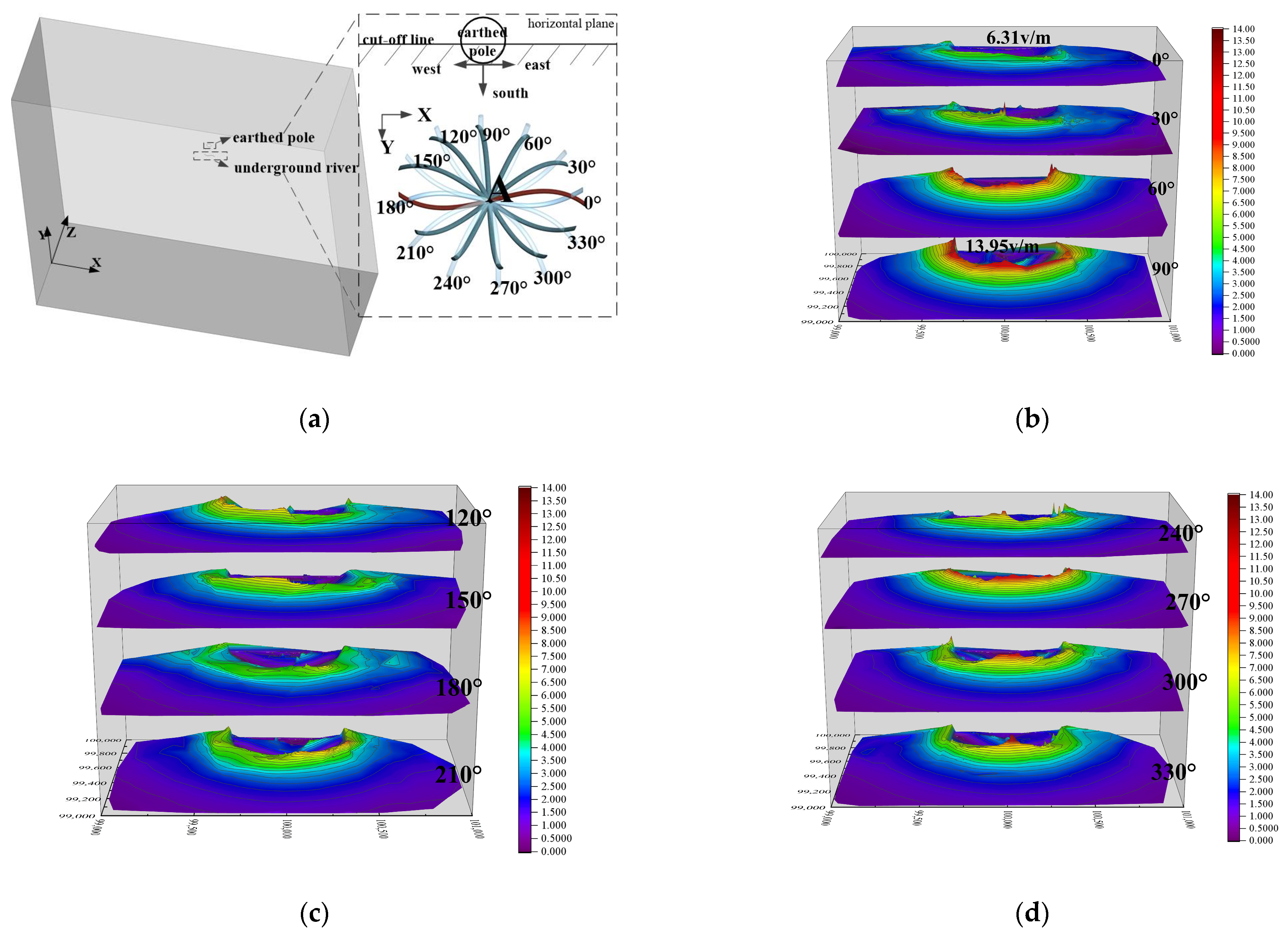
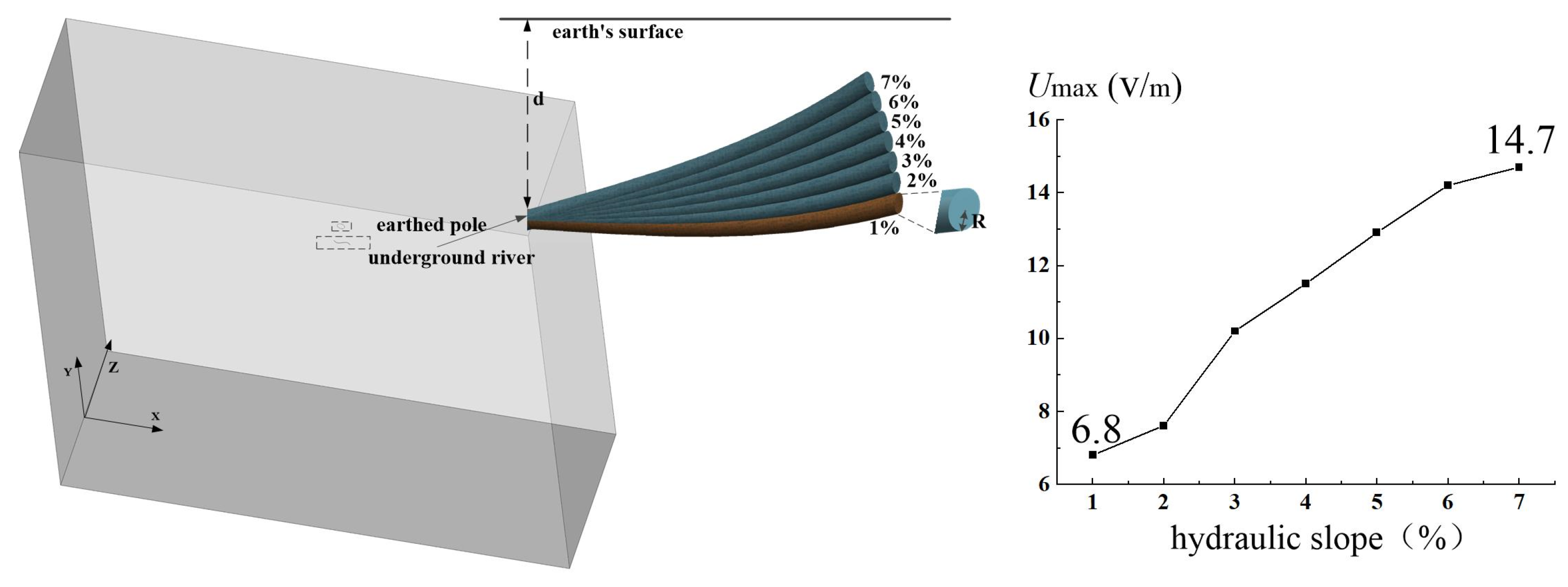
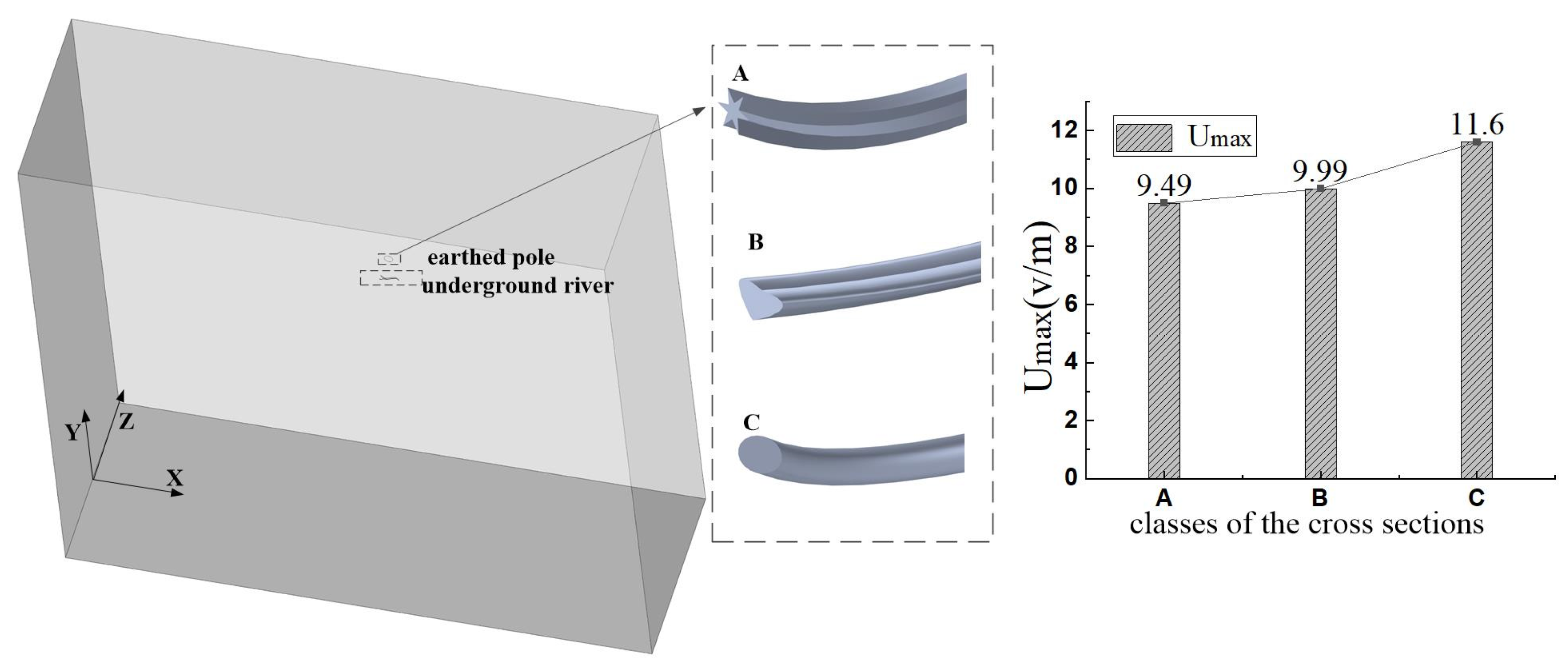
| i | ρi (Ω·m) | hi (m) |
|---|---|---|
| 1 | 52.05 | 5 |
| 2 | 240.01 | 274 |
| 3 | 3843.67 | 1945 |
| 4 | 8542.76 | 3561 |
| 5 | 35,427.81 | 68,577 |
| Classification | |
|---|---|
| filling | Dry karst cave (above 10,000 Ω·m) |
| Semi-filled karst cave (5000–10,000 Ω·m) | |
| Filled with permeable material, such as gravel or coarse sand (500–1000) Ω·m | |
| Filled with weakly permeable material, such as microscale sand or silt (100–300) Ω·m | |
| Water-filled cave (Less than 50 Ω·m) | |
| Karst cave filled with impervious material, such as clay (5–30 Ω·m) | |
| volume | Small cave: radius 0.1–0.5 m, volume less than 10 m3, height 10–318 m |
| Medium cave: radius 0.5–3 m, volume 10–100 m3, height 10–318 m | |
| Large cave: radius 1–10 m, volume 100–1000 m3 | |
| Filling | Position | Volume | Shape |
|---|---|---|---|
| semi-water, semi-filled permeable substances (275–525 Ω·m) | runoff dissolution belt (apart from surface 45–325 m) | super-large karst cave (above1000 m3) | hydraulic slope 2.9–12.7% |
| semi-water, semi-filled weakly permeable material (75–175 Ω·m) | vertical infiltration dissolution zone (apart from surface 30–170 m) |
| Dark River | Swallet Stream | Undercurrent | ||
|---|---|---|---|---|
| resistivity (Ω·m) | 300 | 300 | 150 | |
| volume (m3) | about 4.5 × 106 | about 2.8 × 106 | about 2.1 × 107 | |
| position | vertical position 1 | 30 m | 65–144 m | 100–325 m |
| horizontal position 2 | 800 m | 1500 m | 800 m | |
| rotation position | 0 degrees | 0 degrees | 0 degrees | |
| hydraulic slope | 12% | 3% | 8% | |
| shape | whole shape | multiple development branch holes | single tunnel | development branch hole |
| cross-sectional shape | irregular | keyhole type | the shape of a pothole | |
| (X, Y) | d (m) | (X, Y) | d (m) |
|---|---|---|---|
| (0, 10) | 350.06 | (200, 90) | 173.15 |
| (10, 30) | 341.03 | (300, 350) | 350.09 |
| (50, 30) | 301.17 | (600, 10) | 250.08 |
| (100, 30) | 251.4 |
| Category | Volume (m3) | Radius (m) | Umax (V/m) |
|---|---|---|---|
| A | 10 | 1.34 | 9.367 |
| B | 50 | 2.29 | 9.706 |
| C | 1000 | 6.2 | 9.999 |
| D | 1,000,000 | 62.05 | 10.647 |
| Numbering | Half Axis a (m) | Half Axis b (m) | Half Axis c (m) | U (V/m) | Kx |
|---|---|---|---|---|---|
| 1 | 6.2 | 6.2 | 6.2 | 9.96 | 1 |
| 2 | 1.24 | 13.88 | 13.88 | 11.08 | 0.089 |
| 3 | 1.24 | 138.8 | 1.39 | 10.05 | 0.89 |
| 4 | 1.24 | 1.39 | 138.8 | 11.4 | 0.0089 |
| 5 | 0.62 | 19.63 | 19.63 | 11.14 | 0.0316 |
| 6 | 0.62 | 13.88 | 27.76 | 11.2 | 0.022 |
| Numbering | Height (m) | Radius or Other Bottom Parameters (m) | Umax (V/m) | Kx |
|---|---|---|---|---|
| 1 | 238.16 | 1.16 | 11.8 | 0.00765 |
| 2 | 25.04 | 3.57 | 11.44 | 0.224 |
| 3 | 10 | 5.64 | 11.39 | 0.885 |
| 4 | 7.05 | 6.72 | 11.25 | 1.5 |
| 5 | 1.35 | 15.36 | 11.09 | 17.86 |
| 6 | 10 | length of side: 10 | 11.21 | 1 |
| 7 | 10 | elliptical shaft: 11.29, 2.82 | 11.17 | 1.77 |
| 8 | 10 | length of side: 20, 5 | 11.13 | 2 |
| Numbering | Rx | r (m) | U (V/m) |
|---|---|---|---|
| 1 | 5.07 | 3.16 | 10.3 |
| 2 | 50.71 | 1 | 10.56 |
| 3 | 101.42 | 0.71 | 11.1 |
| Numbering | Height (m) | k | U (V/m) |
|---|---|---|---|
| 1 | 38.22 | 0 | 10.9 |
| 2 | 27.5 | 0.3 | 11.08 |
| 3 | 21.84 | 0.5 | 11.12 |
| 4 | 15.66 | 0.8 | 11.38 |
| Numbering | Sectional Area (m2) | Height (m) | U (V/m) |
|---|---|---|---|
| 1 | 43.512 | 22.98 | 10.31 |
| 2 | 52 | 19.23 | 10.33 |
| 3 | 105.54 | 9.475 | 11.39 |
| 4 | 150.6 | 6.64 | 11.93 |
Disclaimer/Publisher’s Note: The statements, opinions and data contained in all publications are solely those of the individual author(s) and contributor(s) and not of MDPI and/or the editor(s). MDPI and/or the editor(s) disclaim responsibility for any injury to people or property resulting from any ideas, methods, instructions or products referred to in the content. |
© 2024 by the authors. Licensee MDPI, Basel, Switzerland. This article is an open access article distributed under the terms and conditions of the Creative Commons Attribution (CC BY) license (https://creativecommons.org/licenses/by/4.0/).
Share and Cite
Xiong, Q.; Liu, X.; Li, Y.; Xi, L.; Qiu, S. Analysis of the Influence of Complex Terrain around DC Transmission Grounding Electrodes on Step Voltage. Energies 2024, 17, 420. https://doi.org/10.3390/en17020420
Xiong Q, Liu X, Li Y, Xi L, Qiu S. Analysis of the Influence of Complex Terrain around DC Transmission Grounding Electrodes on Step Voltage. Energies. 2024; 17(2):420. https://doi.org/10.3390/en17020420
Chicago/Turabian StyleXiong, Qi, Xiangyi Liu, Yanxin Li, Lingran Xi, and Shuang Qiu. 2024. "Analysis of the Influence of Complex Terrain around DC Transmission Grounding Electrodes on Step Voltage" Energies 17, no. 2: 420. https://doi.org/10.3390/en17020420
APA StyleXiong, Q., Liu, X., Li, Y., Xi, L., & Qiu, S. (2024). Analysis of the Influence of Complex Terrain around DC Transmission Grounding Electrodes on Step Voltage. Energies, 17(2), 420. https://doi.org/10.3390/en17020420






